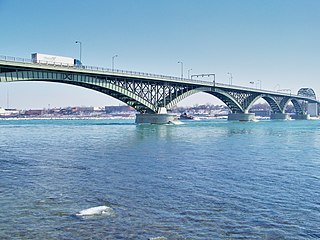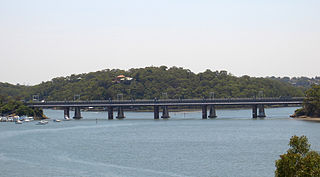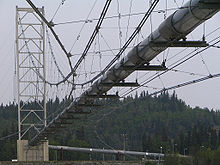
A pipeline is a system of pipes for long-distance transportation of a liquid or gas, typically to a market area for consumption. The latest data from 2014 gives a total of slightly less than 2,175,000 miles (3,500,000 km) of pipeline in 120 countries around the world. The United States had 65%, Russia had 8%, and Canada had 3%, thus 76% of all pipeline were in these three countries.

Rebar, known when massed as reinforcing steel or reinforcement steel, is a steel bar used as a tension device in reinforced concrete and reinforced masonry structures to strengthen and aid the concrete under tension. Concrete is strong under compression, but has low tensile strength. Rebar significantly increases the tensile strength of the structure. Rebar's surface features a continuous series of ribs, lugs or indentations to promote a better bond with the concrete and reduce the risk of slippage.

The Peace Bridge is an international bridge between Canada and the United States at the east end of Lake Erie at the source of the Niagara River, about 20 kilometres (12.4 mi) upriver of Niagara Falls. It connects Buffalo, New York, in the United States to Fort Erie, Ontario, in Canada. It is operated and maintained by the binational Buffalo and Fort Erie Public Bridge Authority.

The Rio–Antirrio Bridge, officially the Charilaos Trikoupis Bridge, is one of the world's longest multi-span cable-stayed bridges and longest of the fully suspended type. It crosses the Gulf of Corinth near Patras, linking the town of Rio on the Peloponnese peninsula to Antirrio on mainland Greece by road. It opened one day before the Athens 2004 Summer Olympics, on 12 August 2004, and was used to transport the Olympic flame.

A culvert is a structure that channels water past an obstacle or to a subterranean waterway. Typically embedded so as to be surrounded by soil, a culvert may be made from a pipe, reinforced concrete or other material. In the United Kingdom, the word can also be used for a longer artificially buried watercourse.

A footbridge is a bridge designed solely for pedestrians. While the primary meaning for a bridge is a structure which links "two points at a height above the ground", a footbridge can also be a lower structure, such as a boardwalk, that enables pedestrians to cross wet, fragile, or marshy land. Bridges range from stepping stones–possibly the earliest man-made structure to "bridge" water–to elaborate steel structures. Another early bridge would have been simply a fallen tree. In some cases a footbridge can be both functional and artistic.

The Bowen Bridge is a segmental cantilever road bridge crossing the River Derwent in Tasmania, Australia. The bridge serves as a vital transportation link in the state capital of Hobart, facilitating the movement of vehicles, pedestrians, and cyclists between the local government areas of Clarence on the eastern shore and Glenorchy on the western shore. The Bowen Bridge links the East Derwent Highway with the Brooker Highway at Glenorchy, approximately 10 kilometres (6.2 mi) from the Hobart city centre.

Bangabandhu Bridge, also known as the Jamuna Multi-purpose Bridge is a bridge opened in Bangladesh in June 1998. It connects Bhuapur on the Jamuna River's east bank to Sirajganj on its west bank. It was the 11th longest bridge in the world when constructed in 1998 and at present is the 6th longest bridge in South Asia. The Jamuna River, which it spans, is one of the three major rivers of Bangladesh, and is fifth largest in the world in discharge volume.

The Walkway over the Hudson is a steel cantilever bridge spanning the Hudson River between Poughkeepsie, New York, on the east bank and Highland, New York, on the west bank. Built as a double track railroad bridge, it was completed on January 1, 1889, and formed part of the Maybrook Railroad Line of the New York, New Haven and Hartford Railroad.

The Columbia–Wrightsville Bridge, officially the Veterans Memorial Bridge, spans the Susquehanna River between Columbia and Wrightsville, Pennsylvania, and carries Pennsylvania Route 462 and BicyclePA Route S. Built originally as the Lancaster-York Intercounty Bridge, construction began in 1929, and the bridge opened September 30, 1930. On November 11, 1980, it was officially dedicated as Veterans Memorial Bridge, though it is still referenced locally as the Columbia–Wrightsville Bridge.
Plains All American Pipeline, L.P. is a master limited partnership engaged in pipeline transport, marketing, and storage of liquefied petroleum gas and petroleum in the United States and Canada. Plains owns interests in 18,370 miles (29,560 km) of pipelines, storage capacity for about 75 million barrels of crude oil, 28 million barrels of NGLs, 68 billion cubic feet of natural gas, and 5 natural gas processing plants. The company is headquartered in the Allen Center in Downtown Houston, Texas. Plains is a publicly traded Master limited partnership. PAA owns an extensive network of pipeline transportation, terminalling, storage and gathering assets in key crude oil and NGL producing basins and transportation corridors and at major market hubs in the United States and Canada.
White Stream is a proposed pipeline project to transport natural gas from the Caspian region to Romania and Ukraine with further supplies to Central Europe.

The Hampden County Memorial Bridge is a reinforced-concrete arch bridge that spans the Connecticut River between Springfield, Massachusetts and West Springfield, Massachusetts, constructed in 1922. The bridge is owned by Massachusetts Highway Department and is located on Massachusetts Route 147. It spans 209 feet (64 m) and rises 29.71 feet (9.06 m) above the river.

High Bridge, also known as the Glory Hole, carries the High Street across the River Witham in the city of Lincoln in eastern England. It is the oldest bridge in the United Kingdom on which buildings still stand.
Benin is a coastal country located in the Gulf of Guinea in Western Africa, which is a resource rich region. Energy in Benin has a diverse energy mix and takes several forms including: solar, wind, hydropower, biomass, fossil resources, and mineral resources. Out of this energy mix, about 60% of energy comes from biomass. Benin is also dependent on energy imports from Ghana and Côte d'Ivoire. While power plants and other energy facilities were built in the 1950s and 1960s, the lack of investment has led to deterioration over time. Similarly, its location in the Gulf of Guinea has led to an attempt of oil production starting in the late 1980s. However, due to unprofitable operations, oil production halted in 1998.

Te Rewa Rewa Bridge is a pedestrian and cycleway bridge across the Waiwhakaiho River at New Plymouth in New Zealand. Its spectacular shape and setting make it a popular landmark.

The Como railway bridge carries the Illawarra railway line across the Georges River between the Sydney suburbs of Oatley and Como.

The Old Como railway bridge is a heritage-listed former railway bridge and now footbridge and water main carrier over the Georges River between Como and Oatley in the Sutherland Shire Council and Georges River Council local government areas of New South Wales, Australia. It was designed by John Whitton and Dept of Railways and built from 1883 to 1885 by C. and E. Millar. The property is owned by Sydney Water, an agency of the Government of New South Wales. It was added to the New South Wales State Heritage Register on 15 November 2002.
Underwater construction is industrial construction in an underwater environment. It is a part of the marine construction industry. It can involve the use of a variety of building materials, mainly concrete and steel. There is often, but not necessarily, a significant component of commercial diving involved. Some underwater work can be done by divers, but they are limited by depth and site conditions, and it is hazardous work, with expensive risk reduction and mitigation, and a limited range of suitable equipment. Remotely operated underwater vehicles are an alternative for some classes of work, but are also limited and expensive. When reasonably practicable, the bulk of the work is done out of the water, with underwater work restricted to installation, modification and repair, and inspection.















